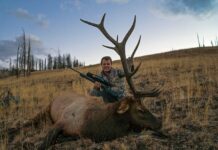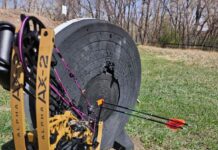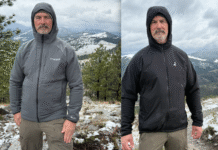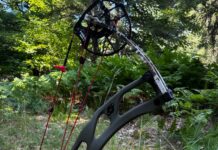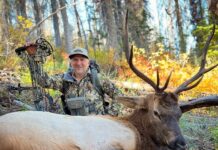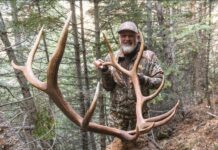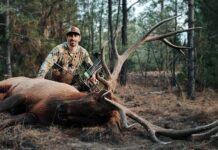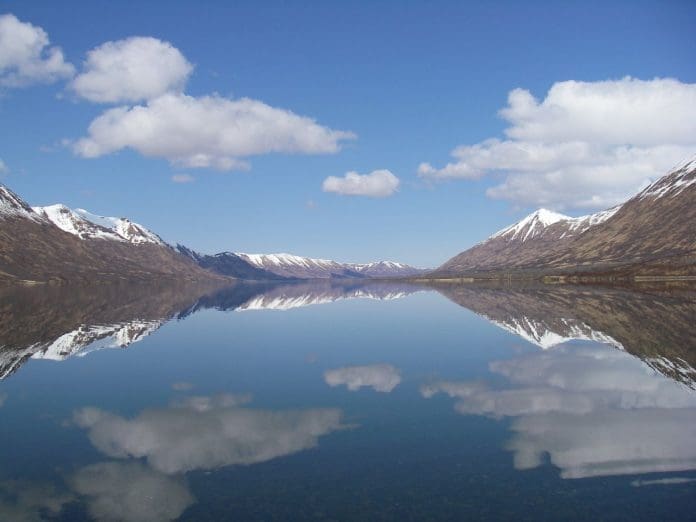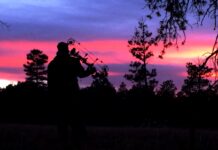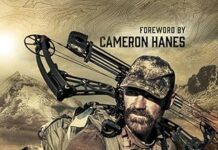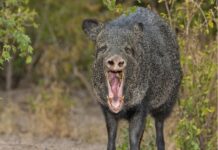A Season of A Grizzly Guide
by Billy Molls
The largest brown/grizzly bears in the world live on Kodiak Island and on the Alaska Peninsula. They can weigh close to a ton, and stand over 11-feet tall. For the past 15 years I have been lucky enough to guide hunters from across the globe to hunt these giant bruins in both locations. A brown bear hunt in this remote and rugged terrain truly is the adventure of a lifetime. This past year I had, without question, one of the greatest bear seasons of my entire career.
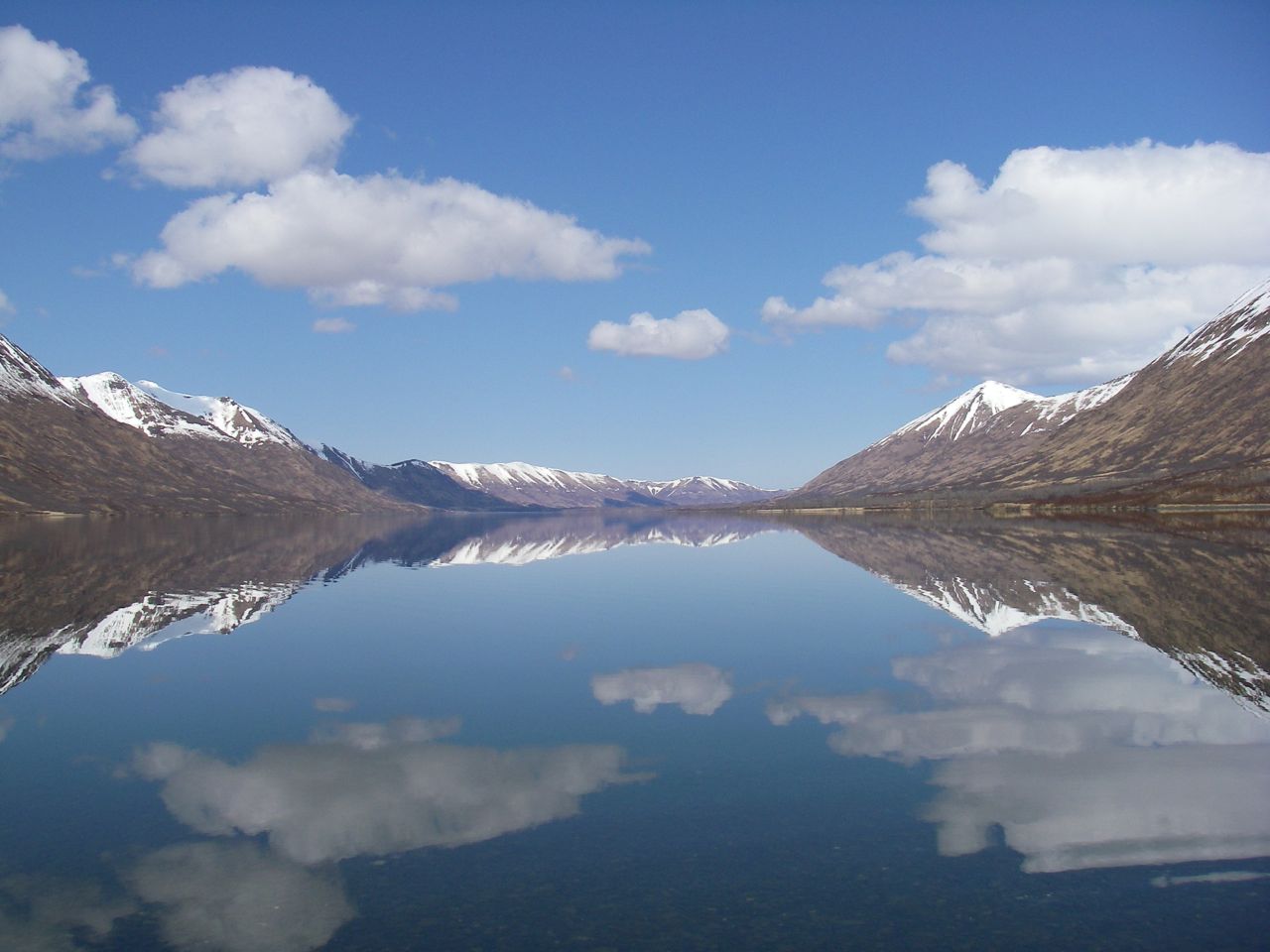
My first hunt took place in early May, near Frazer Lake, on the Western side of Kodiak Island. On this particular hunt the weather was very cold for being that late in the spring, and thus many of the bears were still in their winter dens. My hunter, Ryan Hiatt (North Carolina), and I saw very few bears the first few days of the hunt. On the fourth day the sun came out and so did the bears. In all we saw 12 bears that day before we loaded into our rubber raft and began motoring across the seven-mile long lake back to camp. Along the way I spotted a bear on an open mountainside, one mile distant. I beached the raft on the nearest shore to glass the bear.
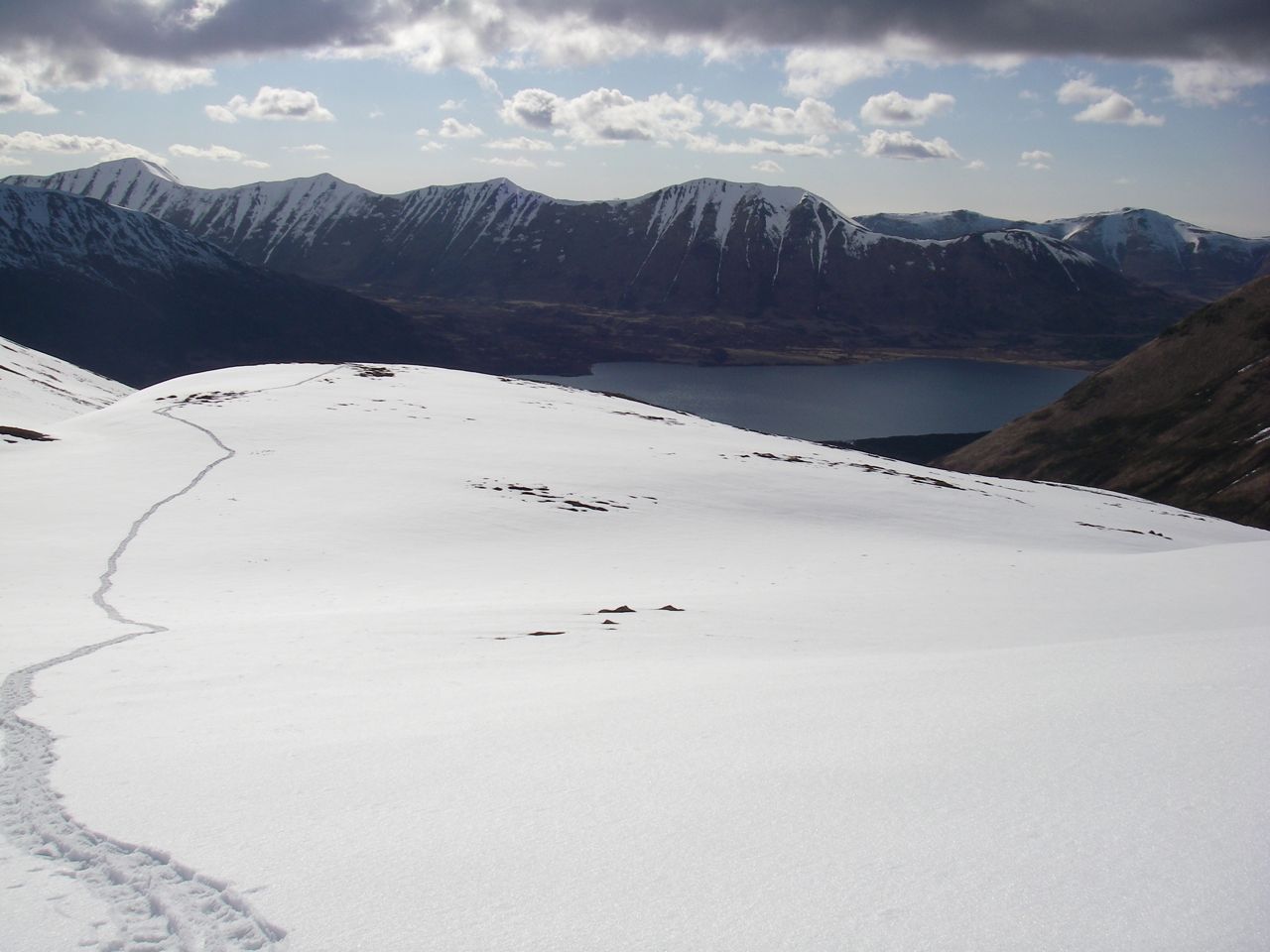 “That’s your bear!” I said almost immediately after finding this giant bear in my scope. “That’s a bear we need to go after.”
“That’s your bear!” I said almost immediately after finding this giant bear in my scope. “That’s a bear we need to go after.”
We were just a few minutes into the stalk when we spotted a different bear. I was positive it was another, smaller boar. When the big bear took off up the mountain chasing the new, younger boar, I knew it was far too late in the day to have any chance of finding him before dark. It was breeding season and I was hopeful that there was sow in heat in the area, and that we might find the big chocolate
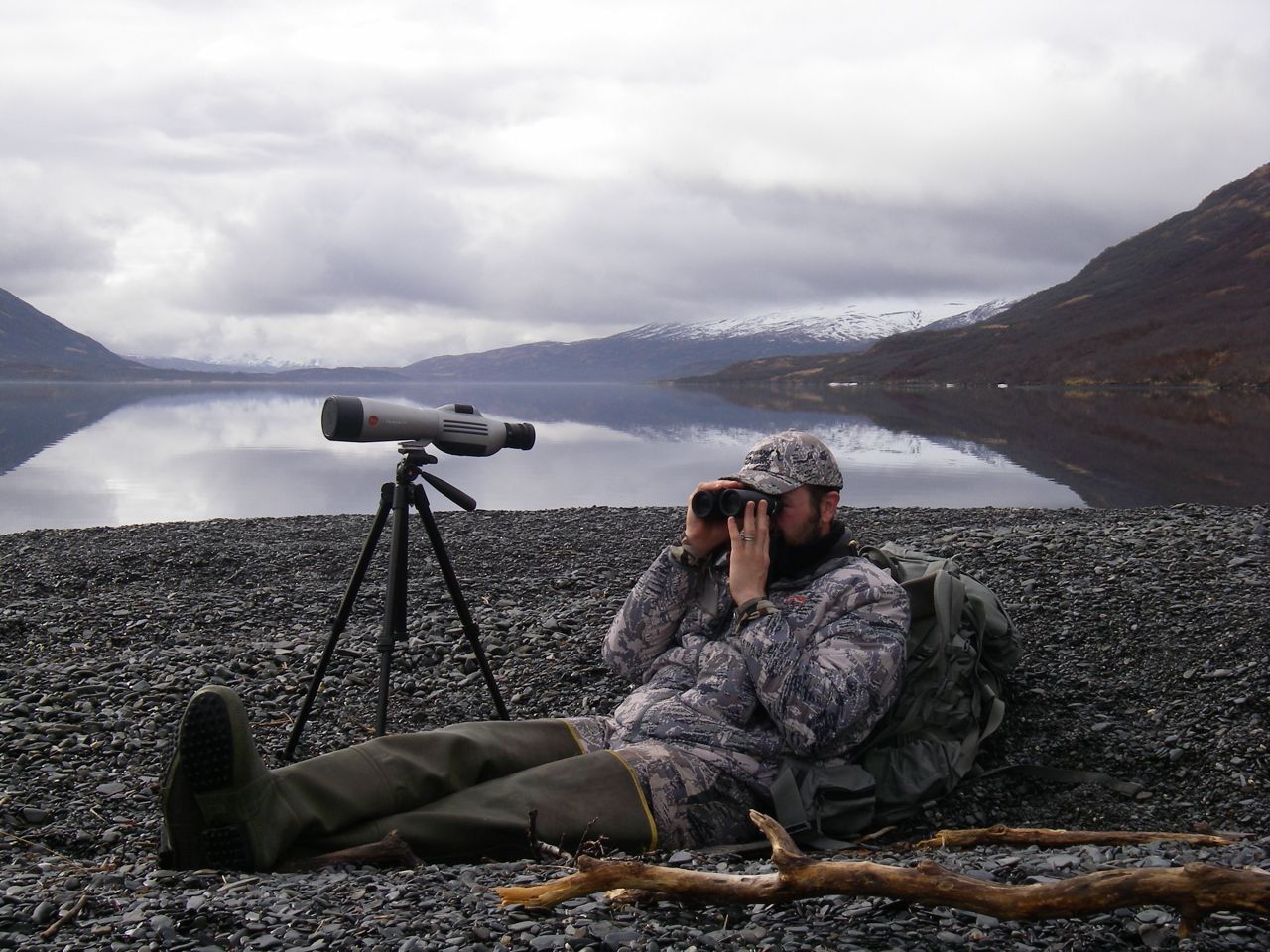 colored 10-footer in the morning.The next day we found a vantage point, on the opposite side of the mile-wide lake, that gave us the best visibility of the 3,500-foot mountain where we spied the bear the evening before. We could see several sets of fresh tracks on the snowy mountain tops. They told me that my hunch was right: There had to be a hot she-bear around somewhere. Surprisingly, we didn’t see any bear movement until 3 pm. Lucky for us, it was the big, dark boar. This time he was high on the mountain in a snow-covered basin with a girlfriend. We quickly loaded into the raft and headed out across the choppy water. As soon as we hit the shore, we stripped of our jackets and outer shirts off and began a three-mile, three-hour stalk. After two miles we hit deep snow that required us to put on our snowshoes. As we crunched through the crusty snow we spotted a sow that I figured had been with the boar we were after. She walked right past us at less than 100 yards. We waited, but the boar never came. We followed the sow’s back trail. At 3,000-foot in elevation crested the ridge where we last saw the boar, I immediately saw a large set of tracks in the snow which led over to the next canyon. I knew we had just missed our opportunity at the huge Kodiak bear. The wind was perfect, so the old boar must have gotten restless and climbed up and over the mountain, which was much too steep for us to attempt to climb. It was a very disappointing trek back to camp that night.
colored 10-footer in the morning.The next day we found a vantage point, on the opposite side of the mile-wide lake, that gave us the best visibility of the 3,500-foot mountain where we spied the bear the evening before. We could see several sets of fresh tracks on the snowy mountain tops. They told me that my hunch was right: There had to be a hot she-bear around somewhere. Surprisingly, we didn’t see any bear movement until 3 pm. Lucky for us, it was the big, dark boar. This time he was high on the mountain in a snow-covered basin with a girlfriend. We quickly loaded into the raft and headed out across the choppy water. As soon as we hit the shore, we stripped of our jackets and outer shirts off and began a three-mile, three-hour stalk. After two miles we hit deep snow that required us to put on our snowshoes. As we crunched through the crusty snow we spotted a sow that I figured had been with the boar we were after. She walked right past us at less than 100 yards. We waited, but the boar never came. We followed the sow’s back trail. At 3,000-foot in elevation crested the ridge where we last saw the boar, I immediately saw a large set of tracks in the snow which led over to the next canyon. I knew we had just missed our opportunity at the huge Kodiak bear. The wind was perfect, so the old boar must have gotten restless and climbed up and over the mountain, which was much too steep for us to attempt to climb. It was a very disappointing trek back to camp that night.
We hunted that same area for the next four days and passed on some smaller bears, and several bears whose hides were rubbed too badly to consider shooting, before finally spotting the same giant bear that had given us the slip on the very same mountain. This time the bear was down much lower, and he was all alone. I knew we now had a much better chance of catching up to him. We raced to the opposite shore to take up the chase. Once again it was a tough stalk through the thick alders that choke the hillsides on this area of the Island. It rained on us for nearly 2 hours before we finally caught up to the old giant bedded in an alder thicket 340 yards away on an adjacent mountain. He was facing our direction, so I decided to make a voice-made predator call to the bear. He immediately shot a glare in our direction. After 3 more calls the bear stood up. I gave another call and he started down to the creek bottom between us. We then hurried 50 yards down to a small clearing where I hoped the bear would come through. With nightfall approaching, thick cover between us and the bear, wet riflescopes, and the dense fog that was closing in on us, I knew the action was going to be fast and furious. The bear was out of sight for about a minute when he finally came out of the creek bottom and into our view. He was 120 yards away, and coming right at us. I instructed Ryan to wait for the bear to turn broadside and anchor him in the shoulder with a bullet from his .375 H+H, but the bear never turned. He just kept coming at us. At less than 60 yards the bear stopped behind an alder bush and stared into our souls.
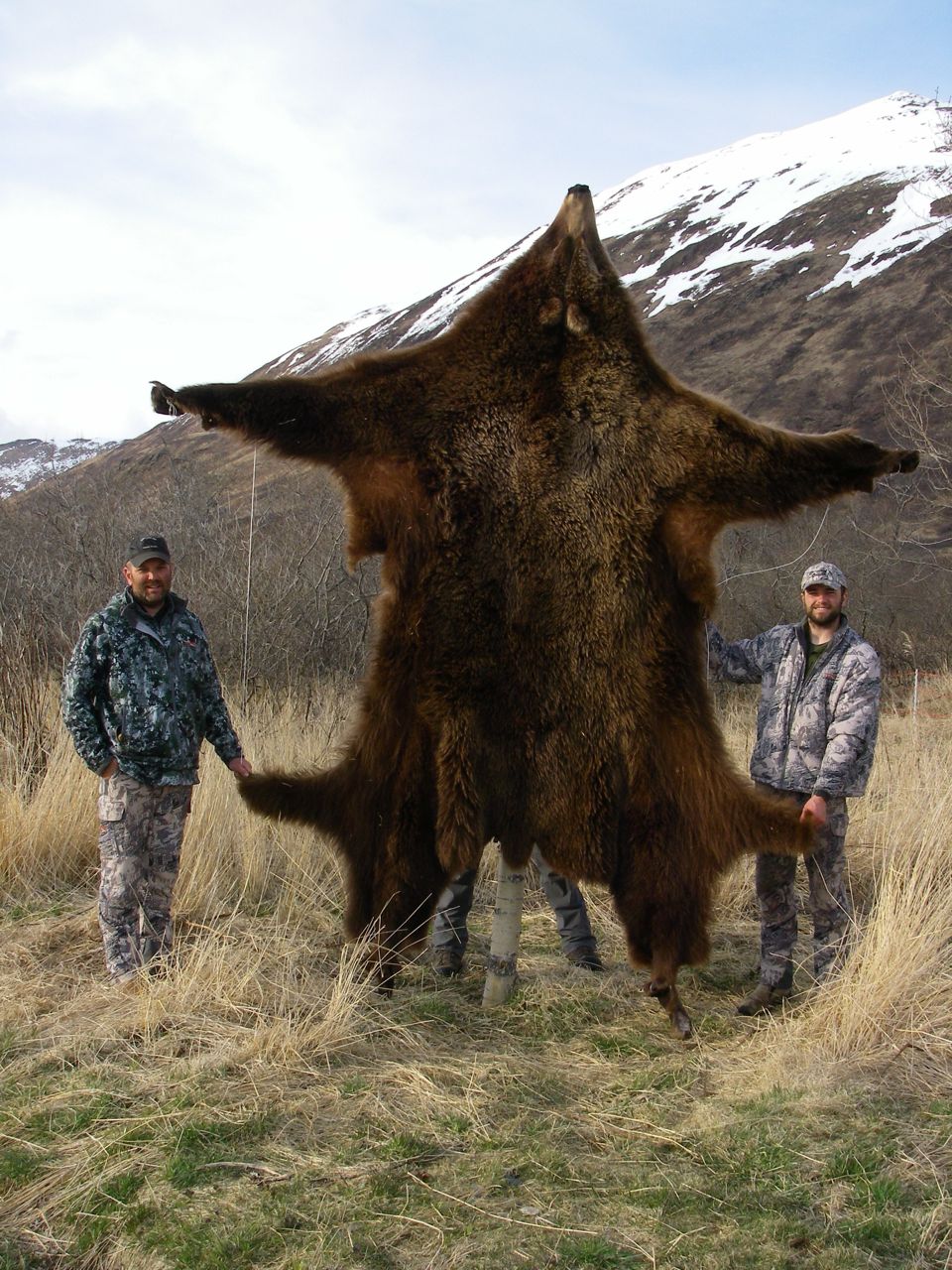 “As soon as you get a clear shot, broadside or not, you better take it,” I instructed Ryan. The bear continued straight to us before turning to our left, and clear of the bush, and offered Ryan a perfect broadside shot. “Take him,” I said as calmly as I could.
“As soon as you get a clear shot, broadside or not, you better take it,” I instructed Ryan. The bear continued straight to us before turning to our left, and clear of the bush, and offered Ryan a perfect broadside shot. “Take him,” I said as calmly as I could.
“Kaboom!” The bear let out a growl and reared back. “Kaboom!” As it turned out Ryan’s second shot was only for insurance as the first shot hit the old bear squarely in the heart.
As we approached the downed animal Ryan was still shaking uncontrollably. He had dreamed of this hunt for 20 years and it had just come true. He shot an honest 10-foot Kodiak brown bear. We spent the next day skinning and packing the 120-pound hide back to camp. After fleshing, the hide measured 10’3” and the skull measured 27-1/2”, which narrowly misses the all-time Boone and Crockett record book.
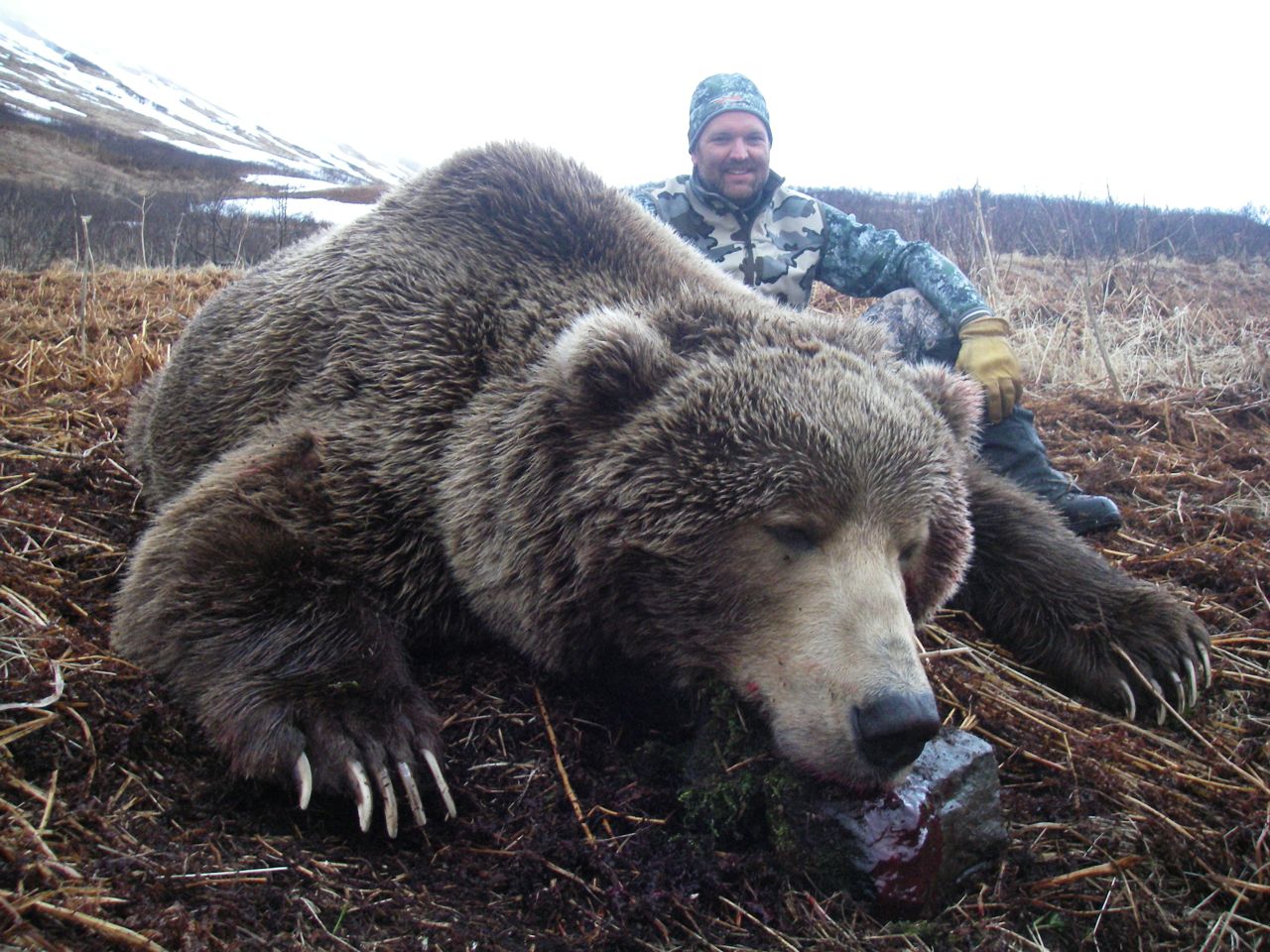
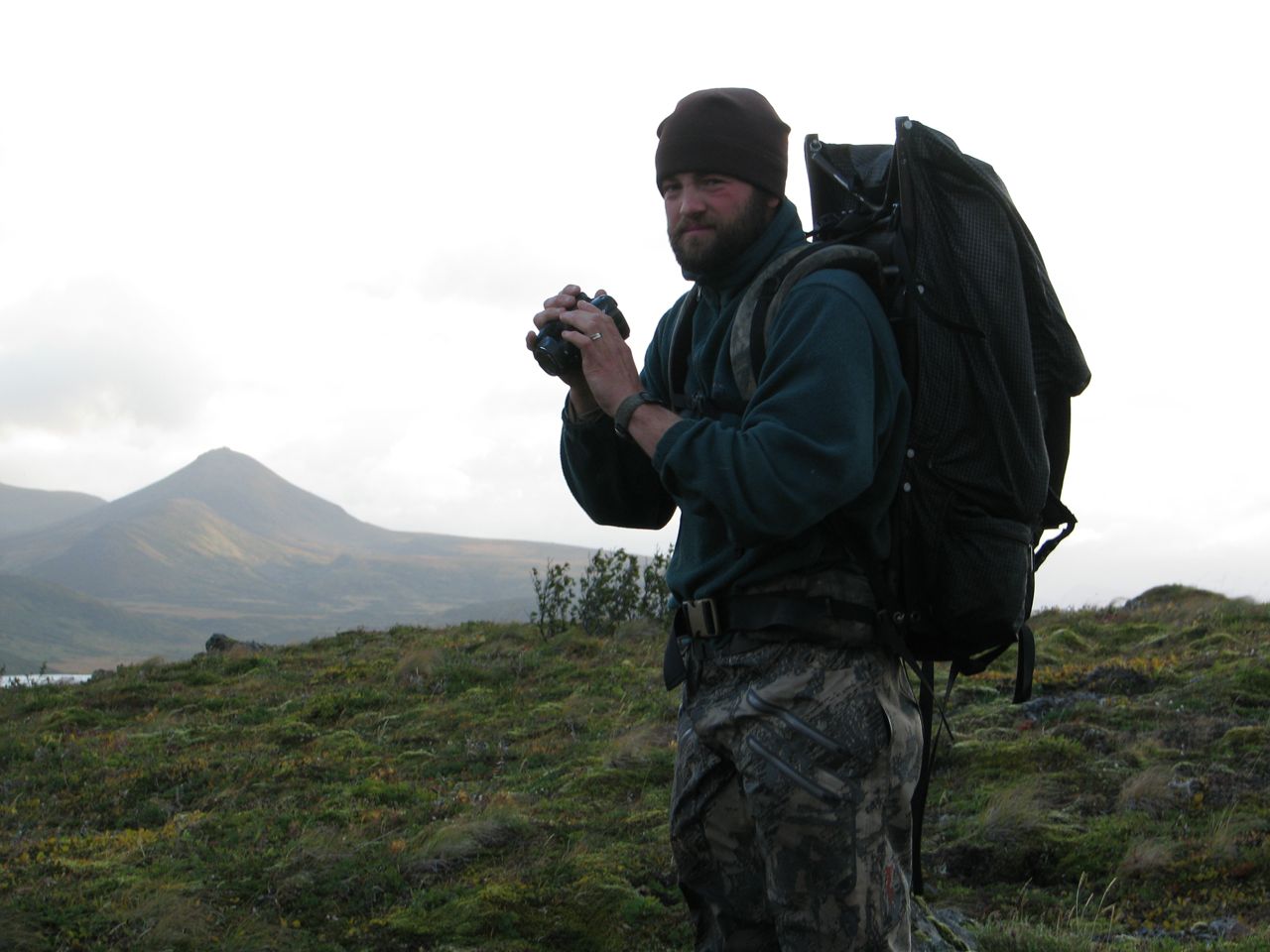 My next brown bear was even more exciting. My hunter, Barry Barton (Pennsylvania), and I were hunting on the Alaska Peninsula in early October during a transition period where the salmon run is ending and the bears begin making their way from the Pacific Ocean and the salmon streams that flow into it, and up to the rugged mountains for hibernation during the frigid Alaskan winter. On the very first day we had huge bear at less than 40 yards on several occasions in the thick alders that lined the stream, but could never get a clear shot. I knew this particular bear very well. I had
My next brown bear was even more exciting. My hunter, Barry Barton (Pennsylvania), and I were hunting on the Alaska Peninsula in early October during a transition period where the salmon run is ending and the bears begin making their way from the Pacific Ocean and the salmon streams that flow into it, and up to the rugged mountains for hibernation during the frigid Alaskan winter. On the very first day we had huge bear at less than 40 yards on several occasions in the thick alders that lined the stream, but could never get a clear shot. I knew this particular bear very well. I had
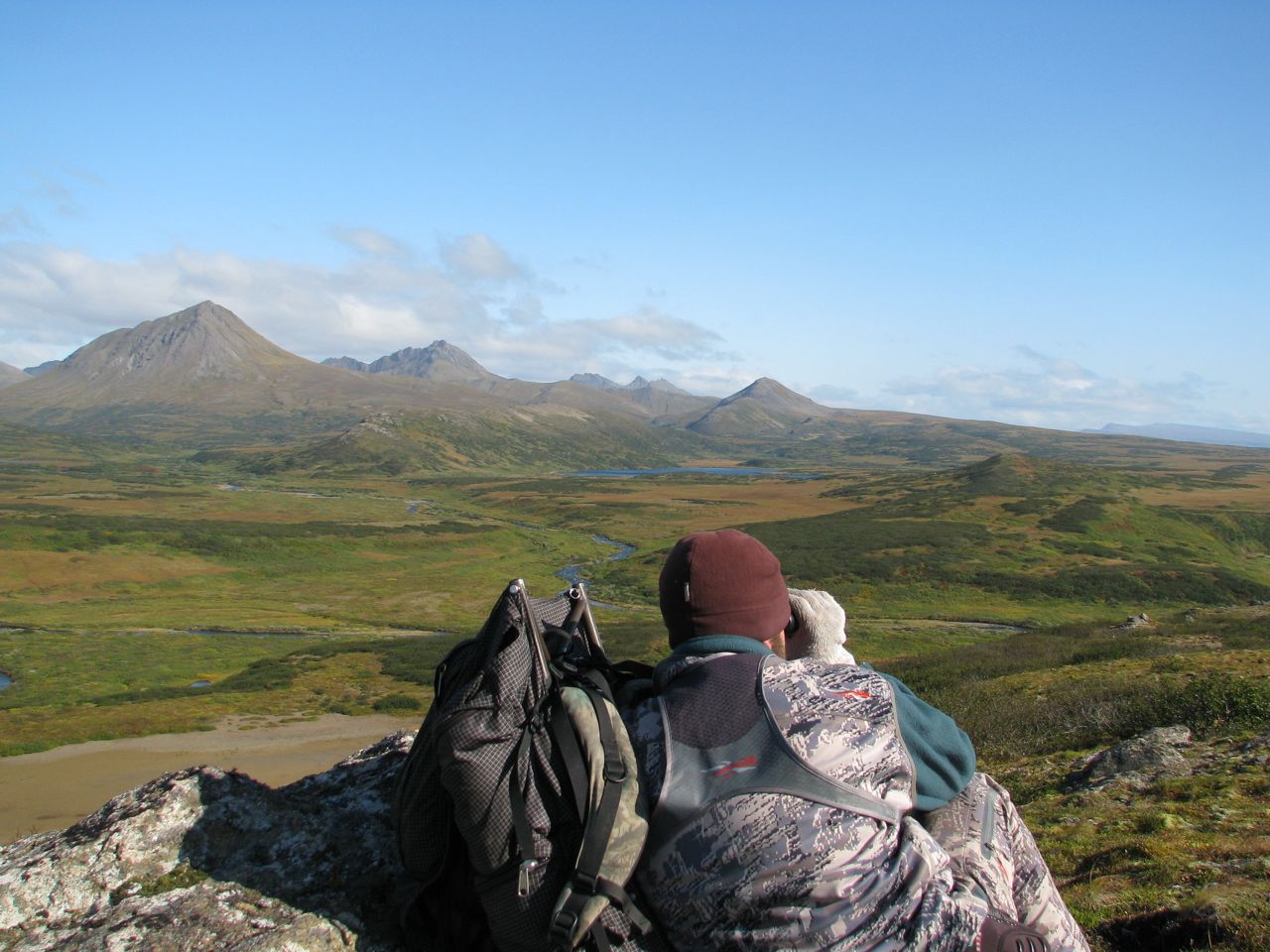 nicknamed him “Blackie” two years earlier. The bear still had the exact same habit of fishing for salmon in the nearby streams in the dark of night, and returning to the dense alder-choked mountainsides at first light, thus never offering any opportunity for my hunter and me to stalk the charcoal colored bruin. On day two we saw the bear again, and chased after him for almost two hours, before we lost him. We couldn’t catch up to him before he disappeared into the alders. I was confident that if we were patient and passed on shooting other smaller bears,that sooner or later we would catch the
nicknamed him “Blackie” two years earlier. The bear still had the exact same habit of fishing for salmon in the nearby streams in the dark of night, and returning to the dense alder-choked mountainsides at first light, thus never offering any opportunity for my hunter and me to stalk the charcoal colored bruin. On day two we saw the bear again, and chased after him for almost two hours, before we lost him. We couldn’t catch up to him before he disappeared into the alders. I was confident that if we were patient and passed on shooting other smaller bears,that sooner or later we would catch the 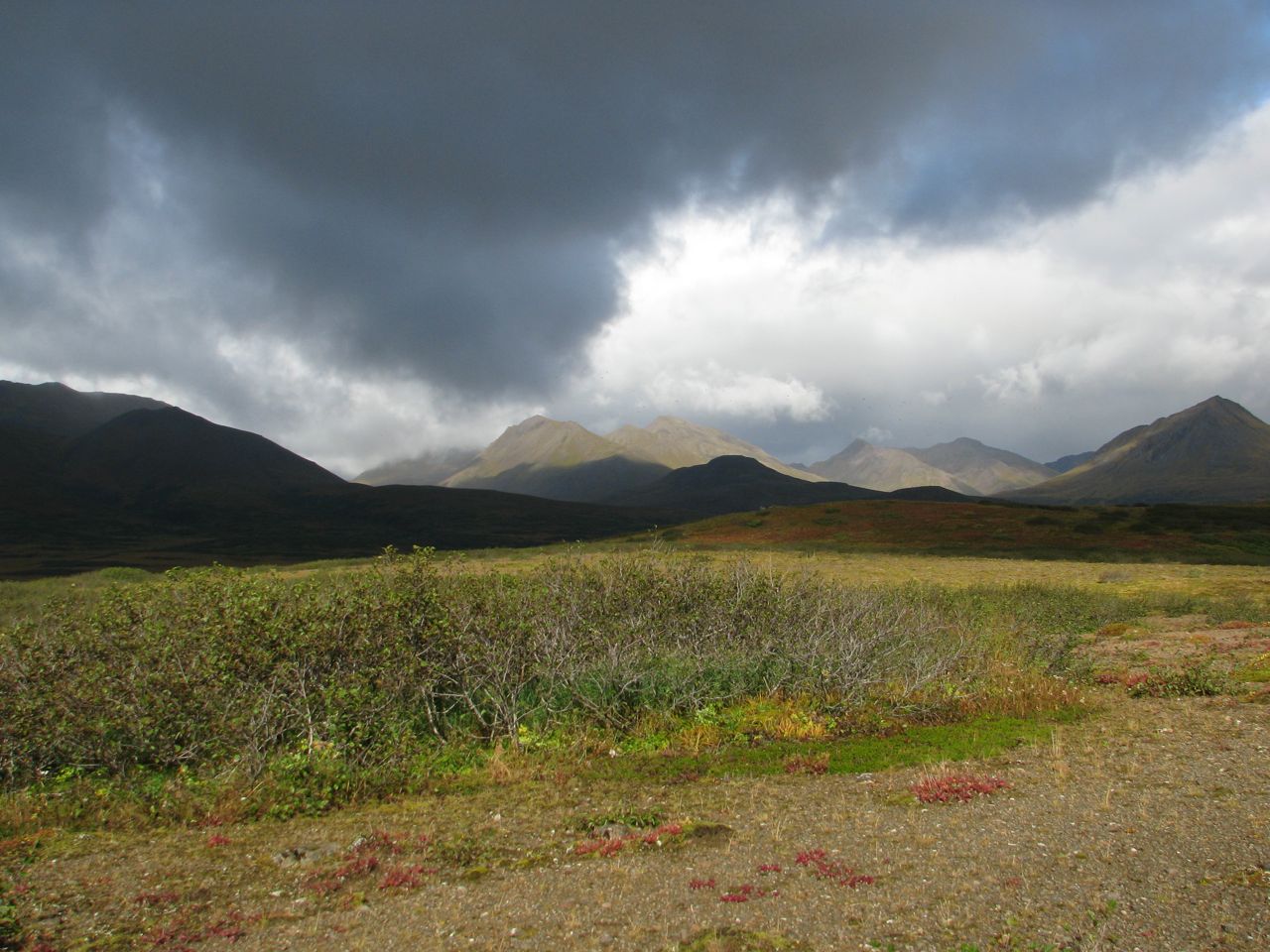 bear in a compromised position.
bear in a compromised position.
As luck would have it, at the brink of dawn on day three, Barry and I caught the bear feasting on the few remaining silver salmon near the same small stream where we had the close encounters with him previously. After a hurried 500-yard stalk we were within striking distance of Blackie. Barry set up in a prone position with his rifle steadied on my backpack. It was further than I like to have a hunter shoot at such a large bear, but after three days of chasing this bear, we had to take the 200-yard shot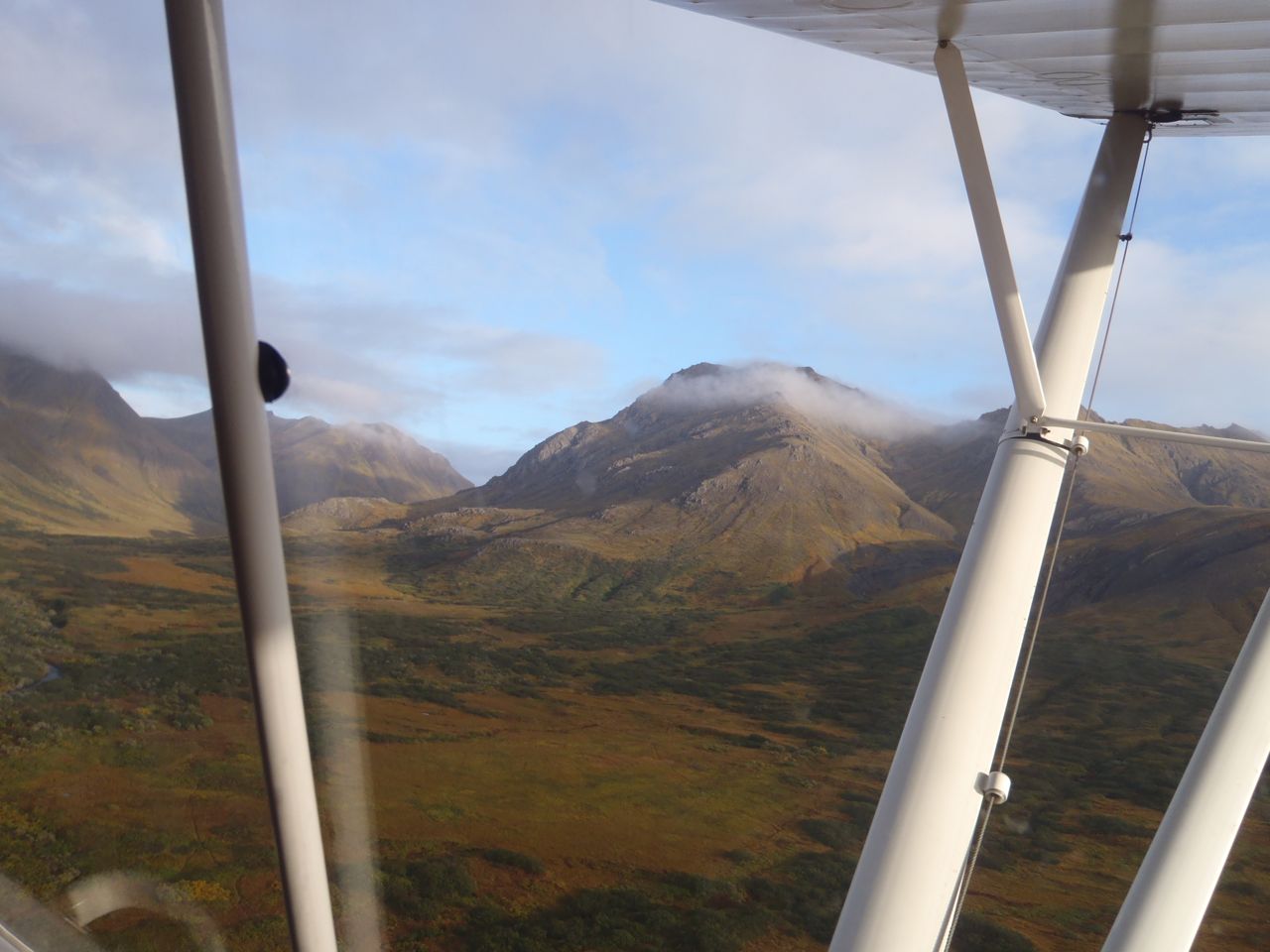 . Barry calmed himself, and made a perfect hit on the feeding bear. He immediately growled and swung to bite his ribs where the bullet struck with a resounding “whump!” The bear took off for the alder bushes, running through the creek. Barry and I each shot the bear again, and the great bear was soon down for good. We later squared the bear at 10’ 8”. He was aged at 17 years old, and had a 28-9/16” skull, which puts the bear well into every record book. It was one of the largest bodied bear I have ever had a hunter take.
. Barry calmed himself, and made a perfect hit on the feeding bear. He immediately growled and swung to bite his ribs where the bullet struck with a resounding “whump!” The bear took off for the alder bushes, running through the creek. Barry and I each shot the bear again, and the great bear was soon down for good. We later squared the bear at 10’ 8”. He was aged at 17 years old, and had a 28-9/16” skull, which puts the bear well into every record book. It was one of the largest bodied bear I have ever had a hunter take.
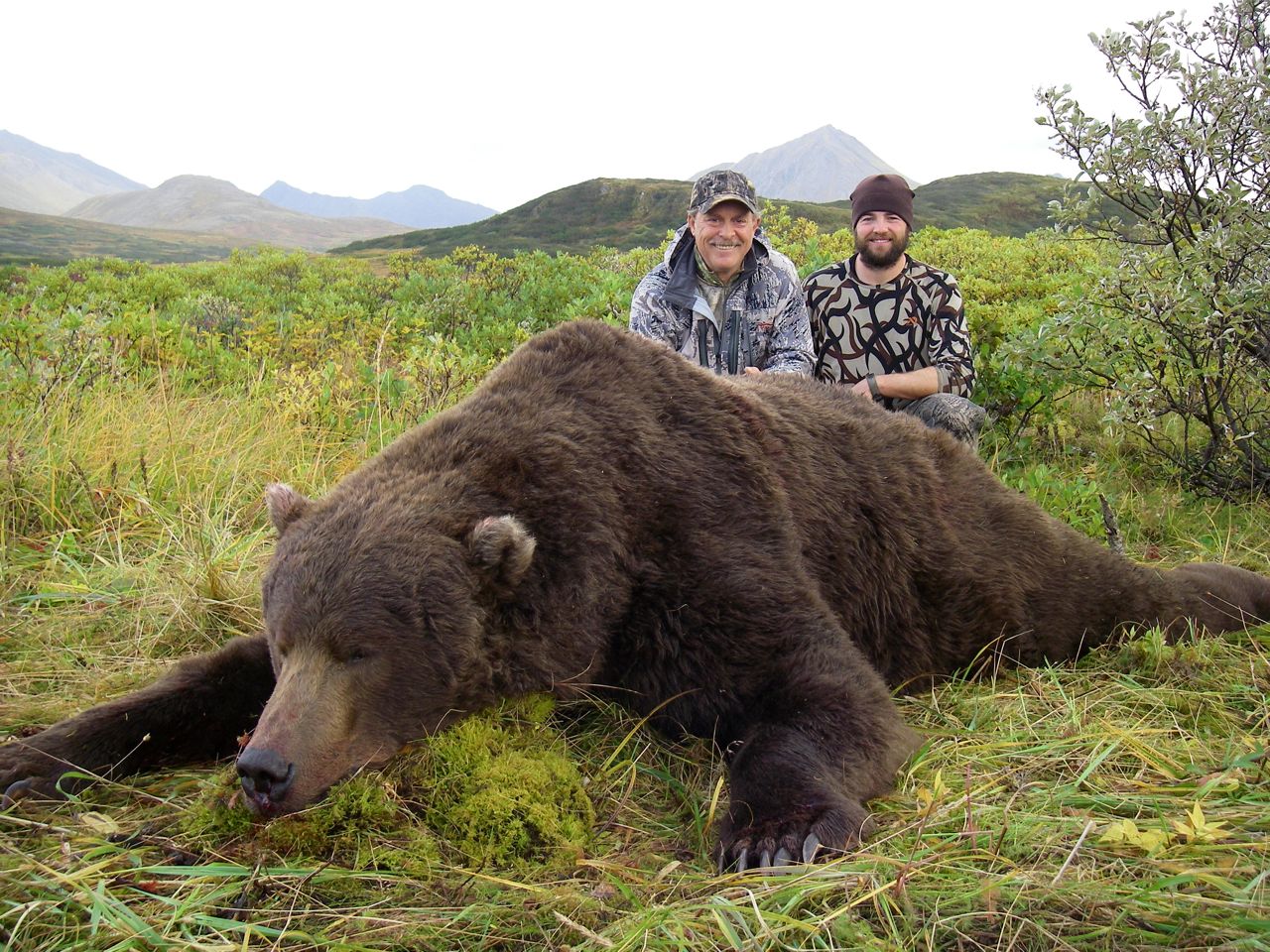
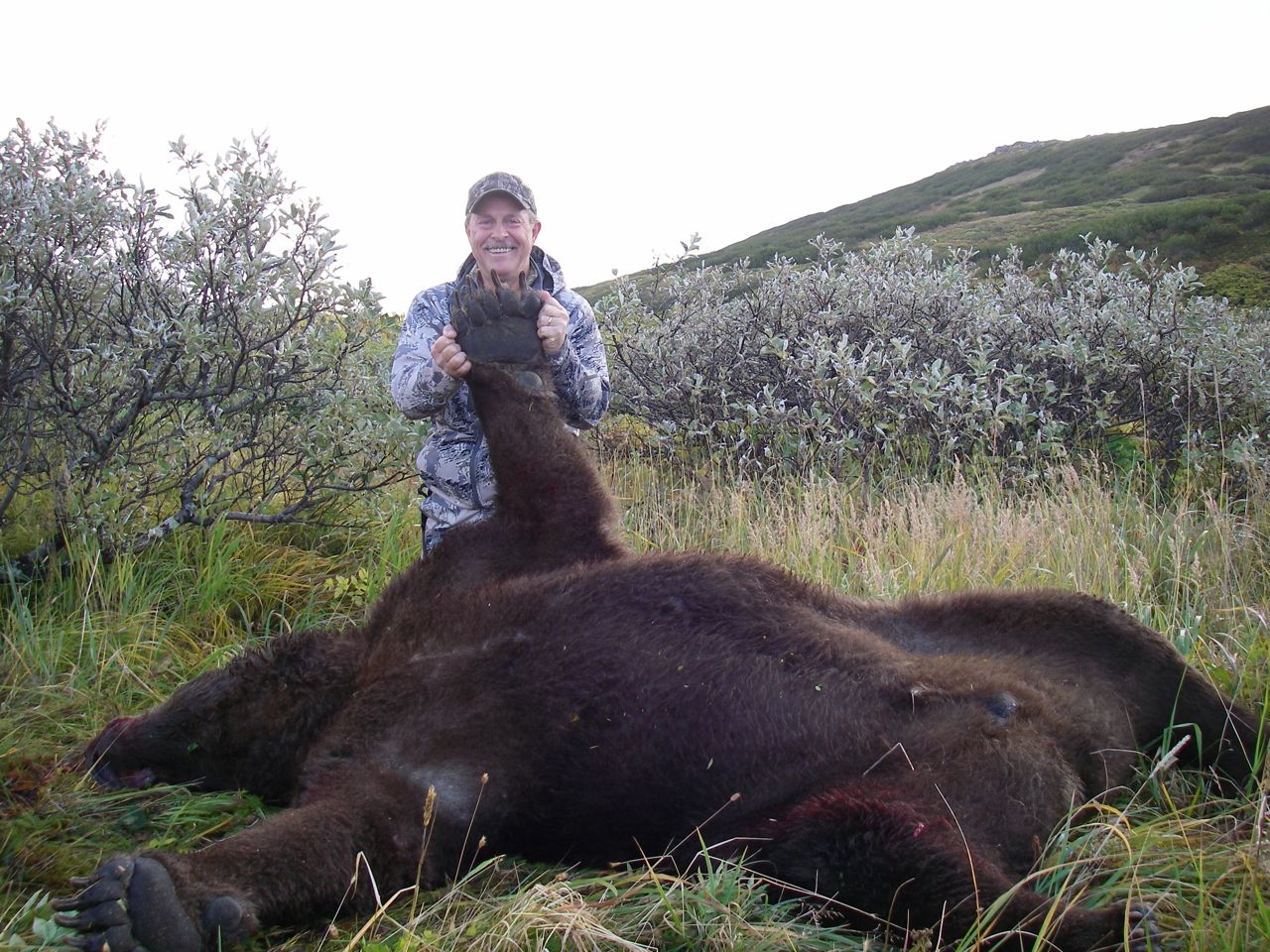
After that hunt I returned to Kodiak in late October for my last hunt of the season. I was flown to an area on the South end, which is very well known for having the biggest bears on the entire island. Despite a light snow and 30 MPH winds, we were able to land on a small lake. I quickly set up my camp as the weather continued to deteriorate. For three days it rained and snowed. The winds gusted over 70 MPH, but I was able to hunker in my tent and wait out the storm. The fourth day dawned to clear skies and calm winds. I knew my hunter would be able to fly into camp. Robert St. Pierre (Oklahoma) arrived shortly before noon. After 3 days of sitting in a hotel in the town of Kodiak, he was ready to hunt. By Alaska law we couldn’t hunt the same day he flew so we checked the zero on Robert’s rifle and got ready for the next day’s hunt. That night we could hear bears fighting over the salmon that filled a small bay on the far side of the lake. We were both very excited to start hunting.
The next morning we were greeted with snow and a 20-degree temperature. By late morning the sun emerged well above the mountains to the East, and we started spotting bears. The first two bears were small sows with out cubs. Just after noon we spotted a large boar, bedded high on a mountainside two miles away. I judged the bear to be well over nine-foot square. Robert decided it was a bear he wanted to pursue. Within two hours we were 200 yards below the bear with no way to get closer without the bear spotting us. Robert set up and took the first broadside shot he could get. His first shot missed. His second connected, and the bear immediately disappeared into the alders. We waited patiently for the bear to emerge from the bushes, but after 5 minutes with no sign of the bear, we were hopeful that he had died in the thick bush. We climbed 50 yards up the steep mountain to begin tracking the bear in the fresh snow, when I caught movement straight above us through the thick alders.
“BEAR!… Coming right at us!” I whispered to my client. The bear clearly heard us approaching and was now hunting us! “Get ready. Be sure your scope is on low power and wait for a clear shot,” I instructed Robert.
We could only see bits and pieces of the bear through the thick, tangled alders. When the boar stepped into a small clearing at 25 yards and looked right at us, we knew it was do or die.
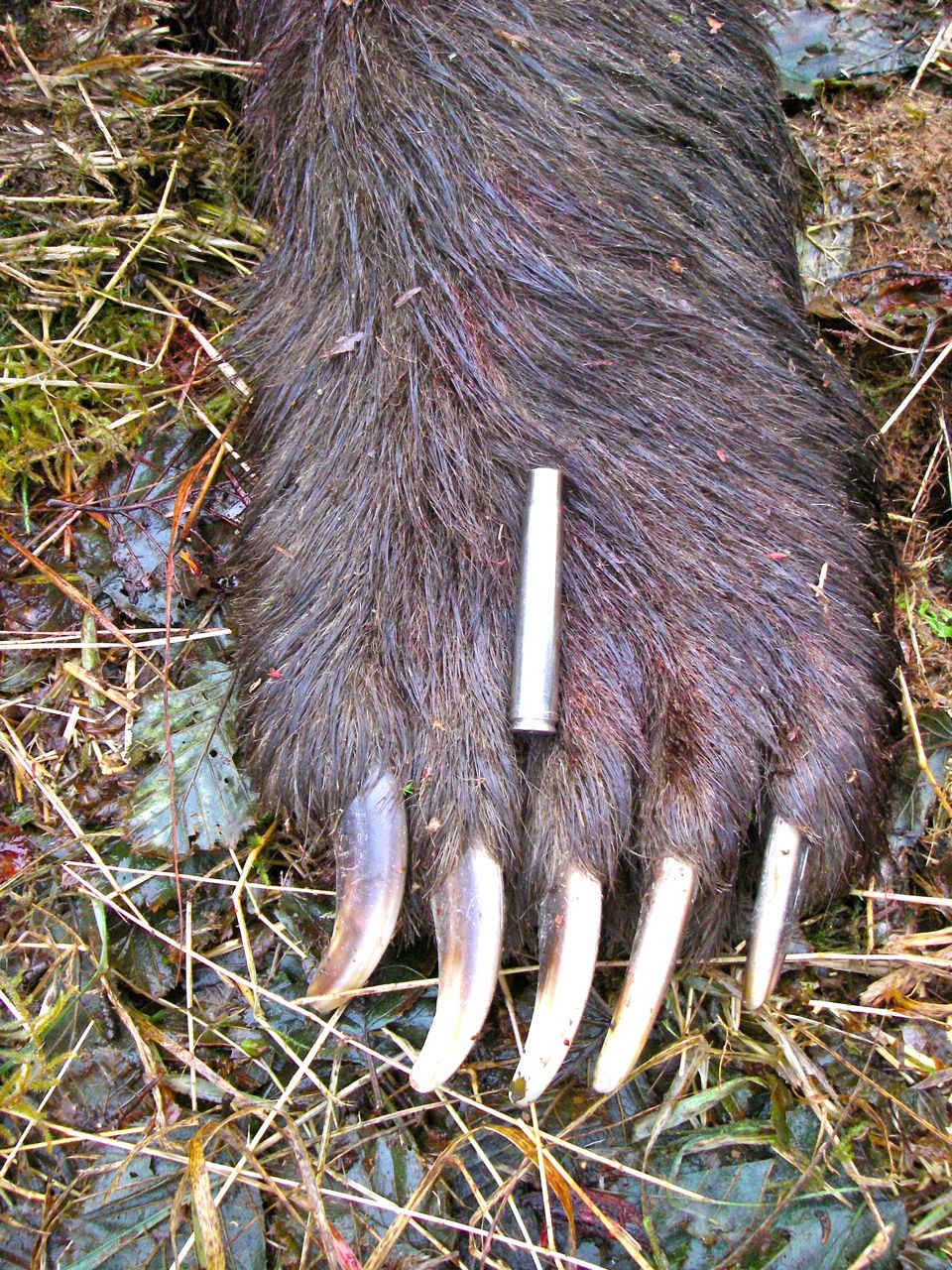 “Kaboom!” Robert’s first shot hit the huge animal low in the shoulder sending him whirling down the mountain through the alder jungle. “Kaboom!,,, Kaboom!” we both fired as he disappeared from our sight.
“Kaboom!” Robert’s first shot hit the huge animal low in the shoulder sending him whirling down the mountain through the alder jungle. “Kaboom!,,, Kaboom!” we both fired as he disappeared from our sight.
After a few minutes we took up the blood trail. It was easy to follow in the fresh snow. I knew this bear would probably still be alive when we found him, so we approached the bear very cautiously. After 300 yards, I set Robert up on a small hill where he could watch the 400 by 600 yard alder thicket that the blood trail led into. I would stay on the blood trail and Robert would shoot the bear if I chased him out of the cover. With our plan in motion, I cautiously continued tracking the wounded bear. After 10 minutes I could see where the bear had been rolling around and biting at, and breaking branches on the alders. I knew I was VERY close. I stood quietly for nearly a minute, before hearing a small twig break. I froze still for a few more seconds and saw movement to my left. I readied my .375 H+H and took two swift side steps. At 25 yards, the bear was looking right at me. When our eyes locked, he immediately got up. I quickly fired at the bears’ shoulder, knocking him back down to the ground. I fired again with a shot into the neck, putting the bear down for good. I gave a loud yell of excitement, relief, and congratulations to Robert. He quickly joined me to admire his fine trophy.
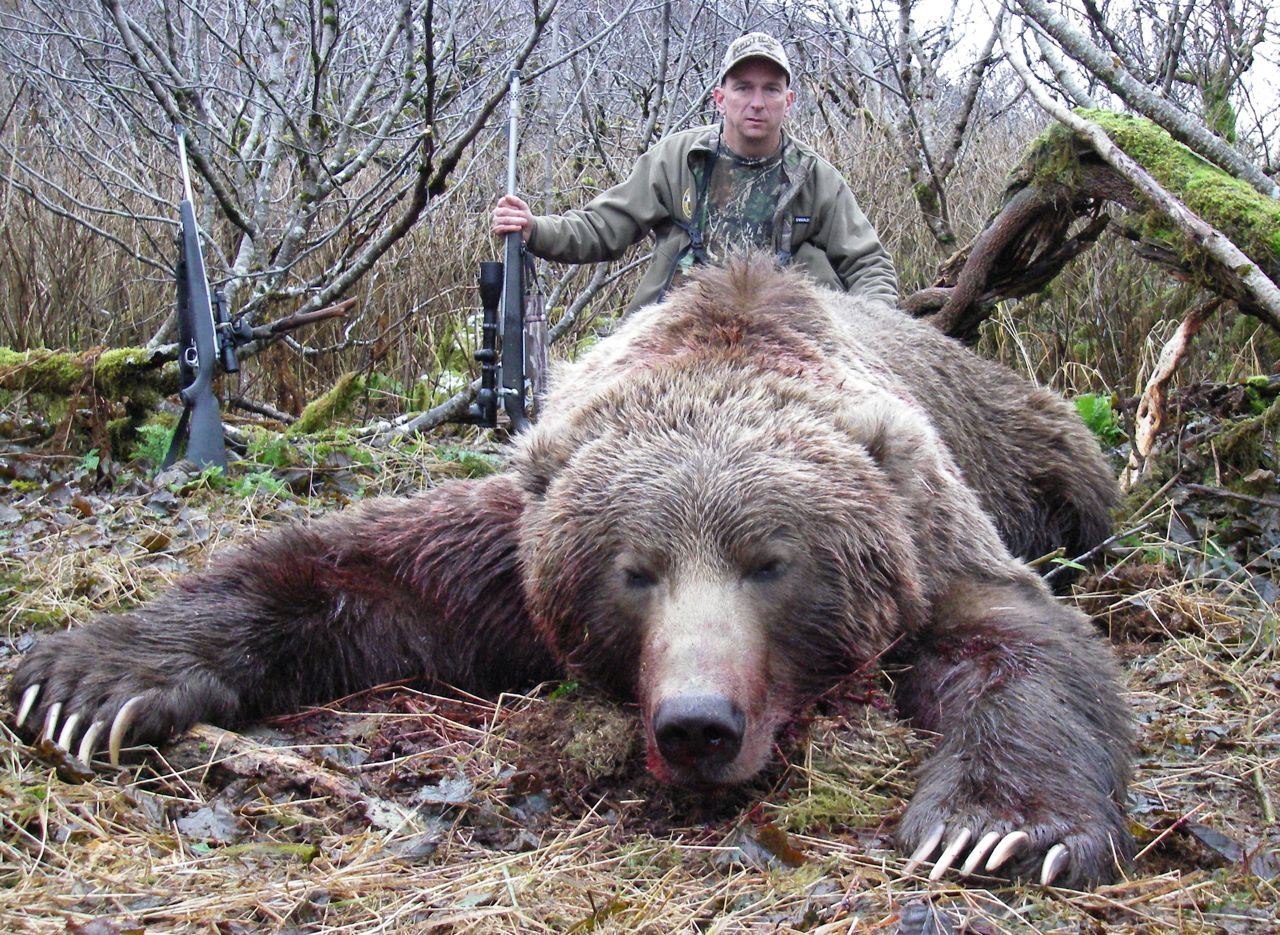
The next morning, as we were heading back to skin the bear, we stumbled onto another bear feeding on a salmon just 50 yards away. The bear quickly finished his meal and started walking right to us. Robert and I stood side-by-side yelling at the bear, but he kept coming! At 35 yards Robert shot in front of the bear, but it didn’t faze him. The bear kept coming, and at 30 yards I fired into a small creek right in front of his long claws. The water and some rocks splashed up into the bear’s face, stopping him in his tracks. We continued yelling with our rifles loaded and ready, knowing that he was going to either leave us alone or charge us immediately. The average sized boar stood on his hind legs and tried to smell us. He then popped his teeth trying to get us to run, but we stood our ground and thankfully, the bear eventually sauntered off.
We continued over to Robert’s bear, and kept a close eye on the alders that surrounded us while skinning, but luckily, never encountered any more hungry bears. We later measured the skull out at 27-1/4” and the hide measured 9’7”. That night, with the plane scheduled to pick us up the following morning, we were wakened by the sounds of at least two more bears fighting 300 yards across the lake. It was just another reminder of the savage and wild nature of this amazing land that I have come to enjoy more and more each season.

